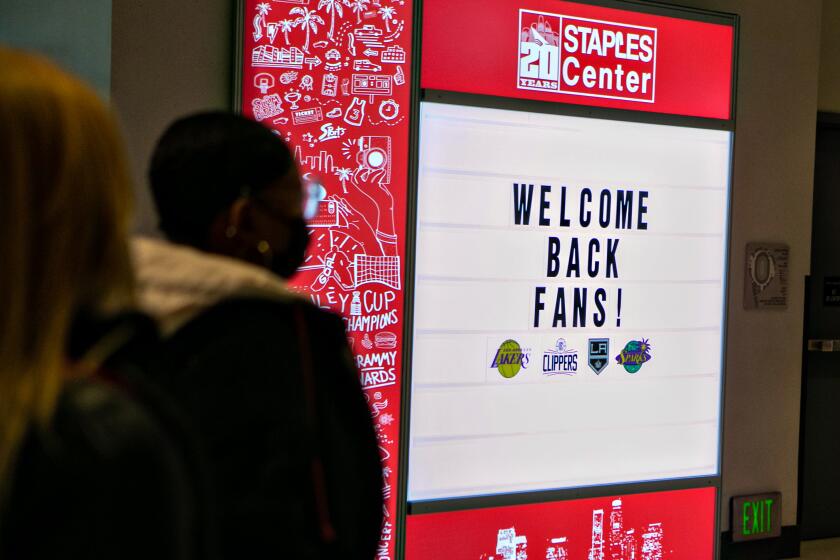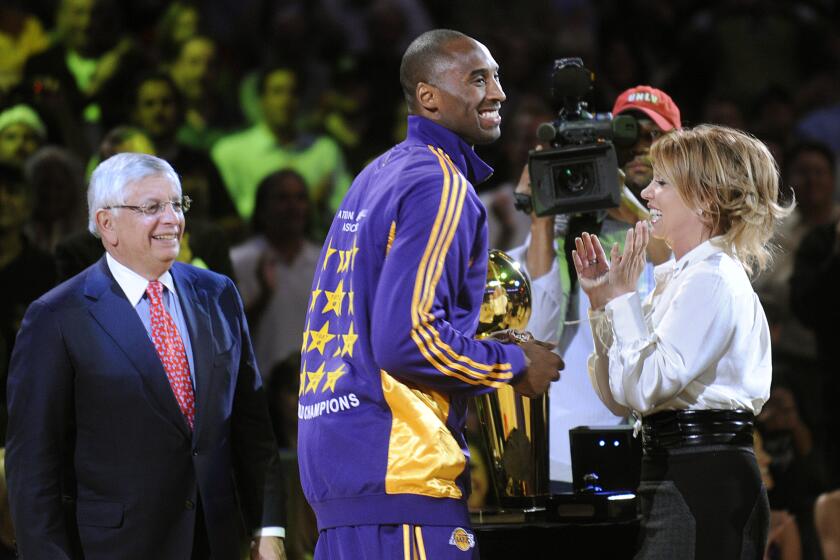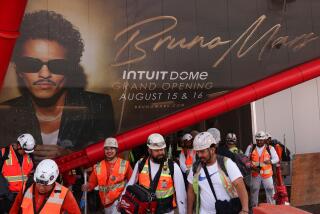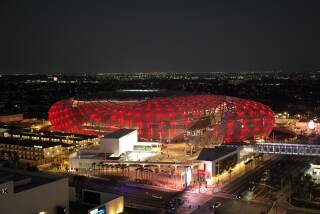Exclusive: Lakers extend Staples Center lease for 20 years
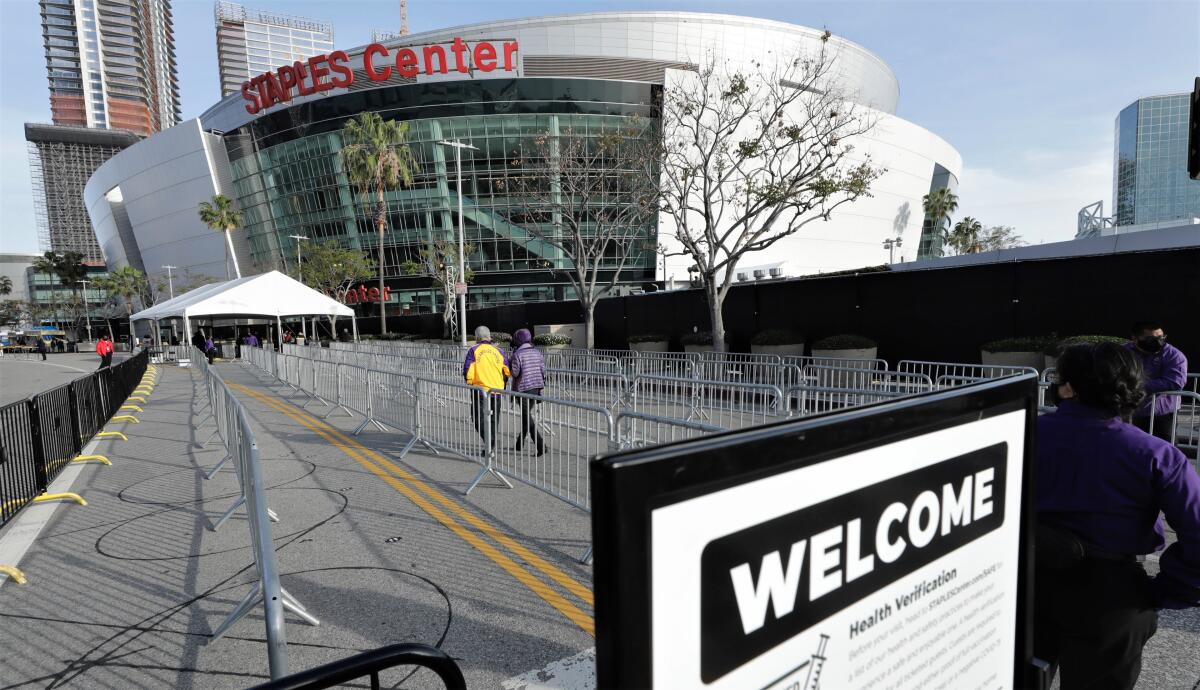
- Share via
With their lease at Staples Center expiring in a few years, the Lakers could have followed the Clippers’ plan, moving to another part of town, building their own arena and keeping all the revenue.
Instead, the defending NBA champions have chosen to stay put.
In a deal expected to be announced Thursday, the franchise will extend its lease with owner AEG for another two decades through 2041. The agreement includes a commitment to spend “nine figures” on capital improvements and upgrades throughout the 22-year-old arena.
A team official said renovations were key to the extension, as was a desire to remain downtown.
“Location, location, location,” said Tim Harris, president of business operations for the franchise. “We’re in the heart of L.A. and the infrastructure is building up all around us.”
It also helped that the Clippers are leaving for Inglewood soon, potentially allowing the Lakers, Kings and Sparks to expand their locker rooms on the arena’s lowest level.
In terms of age, Staples Center ranks around middle of the NBA, where arenas average 20 years old. By 2041, it could rival 53-year-old Madison Square Garden in terms of seniority.
The city of Inglewood has given final approval for the Clippers to purchase the publicly owned land needed to build their $1.8-billion arena project.
But Scott Minto, director of the sports MBA program at San Diego State, says that isn’t necessarily bad.
“I don’t think it hurts a team to be in the same place, provided that the arena does some significant renovations to reinvigorate itself,” Minto said.
Only a few years ago, business mogul Irving Azoff approached the Buss family about moving the Lakers back to Inglewood. In a 2017 email obtained by The Times, Azoff suggested razing and rebuilding the Forum.
The matter was complicated by the fact that AEG head Philip Anschutz controls 27% of the team, with the Buss family owning 66%. (Times owner Patrick Soon-Shiong is another minority investor, owning less than 5%).
The team never followed through on Azoff’s proposal and, around 2019, began discussing a lease extension with AEG and the Kings. The parties brainstormed a wish list of upgrades at every level of the arena, including the highest section where the cheapest seats are.
“That’s my favorite piece,” AEG president and chief executive Dan Beckerman said, adding that changes to the upper concourse will “capitalize on the uniqueness of the proximity to the downtown skyline.”
Lakers fans should expect extensive safety changes, including a ban on all bags, for games at Staples Center.
While no construction details have been announced, the refurbishments will be overseen by the arena’s original designers and could begin within several years. They will focus on creating spaces where people can gather away from their seats, continuing to watch the game either on television monitors or by looking directly over the floor.
The Dallas Cowboys incorporated standing-room only areas when they opened AT&T Stadium in 2009.
“Fans are not the same as they were 25 to 30 years ago,” Minto said. “The trend now is to more open space and mingling. In terms of revenue, it is critical that these upgrades be done.”
Staples Center has the size and flexibility to adapt because of when it was built, the professor said. Many arenas constructed during the 1980s were limited in size to about 500,000 or 600,000 square feet; that thinking changed by the late 1990s and Staples Center comprises 1 million square feet.
Wide concourses and other areas outside the main bowl allow for expansion.
“Staples was built with a lot of new trends in mind and it still has that modern feel,” Minto said. “It can withstand more touch-ups than a lot of places built only a decade before.”
Still, with the Clippers planning a billion-dollar arena complex across from SoFi Stadium, it became crucial for Staples Center to retain its anchor tenant.
“In a lot of ways, the Lakers put the arena on the map, winning three straight championships in our first three years,” Beckerman said. “Their success has had such an impact on our success.”
Lakers owner Jeanie Buss and GM Rob Pelinka talk about their close personal relationships with Kobe Bryant on eve of his Hall of Fame induction.
From the team’s perspective, there was value in sticking to an arena that, as host of major concerts and events such as the Grammy Awards and Democratic National Convention, has become nationally known. The adjacent L.A. Live, with its restaurants and hotels, is a drawing card for fans
“Look, we always wanted to stay at Staples,” Harris said. “We’d grown up with the building.”
The franchise is well aware of the potential revenues from constructing its own venue. Tickets and food are only part of the equation — there is money to be made from new naming rights and renting the space during the offseason. Venue deals often come with surrounding real estate that can be developed.
It is not believed that the Lakers share in any of Staples Center’s corporate sponsorships, parking or food and beverage revenues. They do profit from season ticket sales and a portion of the suites and premium tickets. They can also sell advertising around the court.
Beyond money, the painful experience of leaving the iconic Forum came into play while weighing staying at Staples.
“That was emotionally difficult for the fans,” Harris said. “Change is hard. We really were cognizant of not upsetting the fan base.”
Minto figures that, with a favorable lease, sticking around could be a smart move.
“Being the anchor tenant in downtown L.A., in what is now a very famous arena, is certainly great from a marketing perspective,” he said. “The amenities are there. Staples Center is not a relic.”
More to Read
All things Lakers, all the time.
Get all the Lakers news you need in Dan Woike's weekly newsletter.
You may occasionally receive promotional content from the Los Angeles Times.

